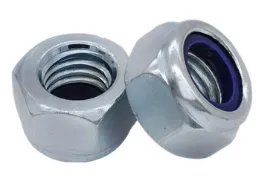Hex Nuts: Classic connectors that tighten the world
Avg . 13, 2025 11:34 Roʻyxatga qaytish
Hex Nuts: Classic connectors that tighten the world
In the world of mechanical connections, Olti burchakli yong'oqlar are important connectors used in conjunction with bolts. With their unique hexagonal structure and reliable fastening performance, they have become indispensable basic components in industrial production and daily necessities, silently guarding the stable connection of countless devices and objects.

The structural design of Hex Nuts contains practical wisdom
The hexagonal shape of DIN934 olti burchakli gayka is the optimal form selected through long-term practice. The six corners provide stable force points for the wrench, making it easy for the tool to quickly clamp and apply torque. Whether it is manual operation or mechanical assembly, it can efficiently complete the fastening operation. The internal threads of the nut are precisely matched with the external threads of the bolt, and the thread profile and pitch are precisely calculated to ensure a tight fit when engaged with the bolt, while also achieving a secure connection through appropriate pre tightening force to prevent loosening.
The material selection of Hex Nuts needs to be flexibly adjusted according to the usage scenario
Under normal working conditions, carbon steel is a commonly used material with low cost and can meet general fastening requirements; In humid and corrosive environments, Hex Nuts made of stainless steel material can maintain the stability of the connection for a long time due to their excellent rust prevention performance; For special environments such as high temperature and high pressure, Hex Nuts made of alloy steel can resist erosion under extreme conditions, ensuring the safety and reliability of the connection parts.
The application range of Hex Nuts is extremely wide
In construction engineering, DIN934 olti burchakli gayka is used in conjunction with bolts to fix steel structural components, making great contributions to the stability of bridges and high-rise buildings; In the field of mechanical manufacturing, Hex Nuts are the key to connecting various components of machine tools and mechanical equipment, ensuring precise coordination of each part during equipment operation; In the automotive industry, from the engine to the chassis, a large number of Hex Nuts tightly connect various components to ensure the safety of vehicle operation; In daily life, the assembly of furniture, appliances, and other items also relies on its presence.
With the development of industrial technology, Hex Nuts is also constantly optimizing and upgrading
Olti burchakli yong'oqlar effectively enhance their anti loosening performance by adding nylon rings to the threads and using deformable threads, ensuring they remain tight even in vibration environments; High strength Hex Nuts are treated with special technology to enhance their load-bearing capacity and meet the high-strength connection requirements of large-scale projects; In addition, lightweight Hex Nuts reduce material consumption by optimizing their structure, achieving energy conservation and consumption reduction while ensuring performance.
In summary, Hex Nuts has become an important cornerstone in the field of connectivity due to its classic hexagonal structure, diverse material selection, wide range of application scenarios, and continuous innovation and upgrading. Although it may seem simple, it ensures the stable operation of various equipment and objects in industrial production and daily life with reliable fastening performance. In the future, with the advancement of technology, Olti burchakli yong'oqlar will continue to improve in performance and functionality, continuing to play an irreplaceable role in connecting the world.
Hex Nuts FAQs
What are the standard sizes of Hex Nuts?
The size of Hex Nuts is usually marked in metric (such as M6, M8) or imperial (such as 1/4 ", 3/8"), corresponding to the thread diameter of the bolt. The common metric specifications range from M3 to M64, while the imperial specifications range from # 4 to 2 inches, depending on international standards (such as ISO, DIN) or national standards (such as GB).
How to distinguish between regular hex nuts and lock nuts?
Ordinary Hex Nuts have a single-layer structure, while anti loosening nuts are usually designed with special features (such as nylon inserts, double nut structures, or serrated bottoms) to prevent loosening by increasing frictional resistance or mechanical locking, such as Nylon Insert Lock Nut.
What are the materials of Hex Nuts? How to choose?
Common materials include carbon steel (such as 4.8 grade, 8.8 grade), stainless steel (304/316), brass, and titanium alloy. When choosing, consideration should be given to the environment (such as corrosion resistance), load strength (such as matching high-grade nuts with high-strength bolts), and cost.
Do you need washers when installing Hex Nuts?
Depending on the situation: gaskets can disperse pressure (on soft material surfaces), prevent loosening (on spring gaskets), or isolate electrochemical reactions (such as stainless steel nuts with aluminum surfaces). But high-strength connections or self-locking nuts may not require washers.
How to deal with Hex Nuts slipping or rusting?
Sliding wire: Try using a wrench to secure the bottom of the nut, or forcefully remove it using a nut separator/pliers.
Rusting: Spray bolt loosening agent (such as WD40), let it stand and gently tap and vibrate it; Stubborn corrosion can be treated by thermal expansion and contraction method (local heating) or cutting nuts.
So'ngi yangiliklar
-
Bolts for Lawn Mower Handle Supplier | OEM & Rust-Resistant
YangiliklarNov.17,2025
-
Silver Screws Supplier | Corrosion-Resistant, Bulk & Custom
YangiliklarNov.17,2025
-
Cabinet Bolts Supplier | OEM, Bulk Stock, Fast Shipping
YangiliklarNov.17,2025
-
Axle Nuts Supplier - OEM-Grade, ISO-Certified, Fast Delivery
YangiliklarNov.17,2025
-
Wire Bolts Suppliers – OEM Factory Prices, ISO Quality
YangiliklarNov.11,2025
-
Bolts for Lawn Mower Handle Supplier – OEM & Anti‑Rust
YangiliklarNov.11,2025
